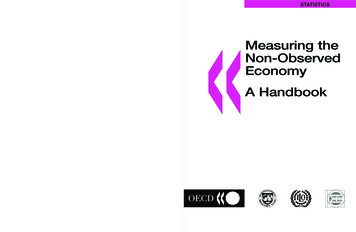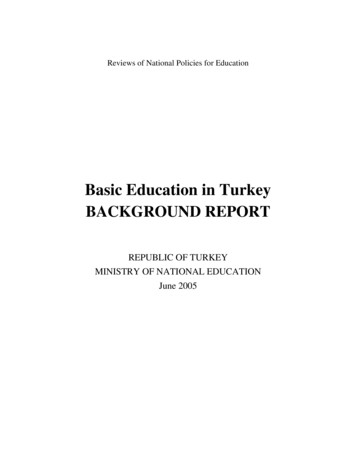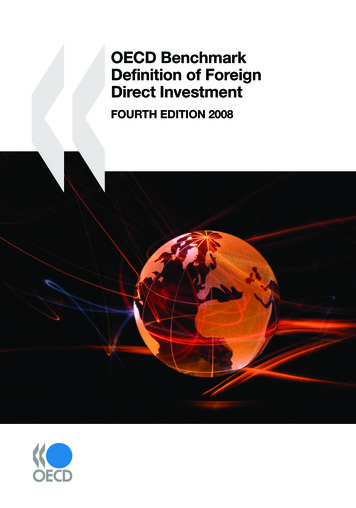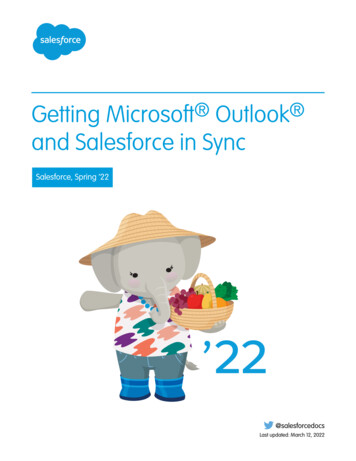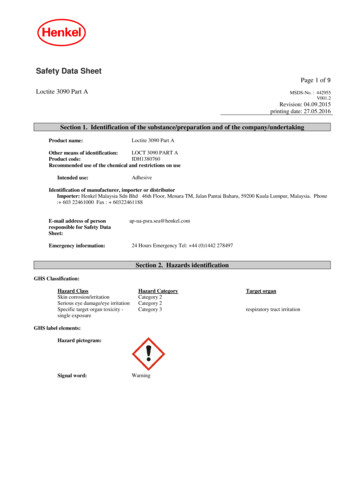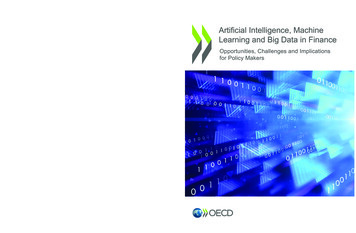
Transcription
SUSTAINABLE AND RESILIENT FINANCEArtificial Intelligence, MachineLearning and Big Data in FinanceOECD Business and Finance Outlook 2020The OECD Business and Finance Outlook is an annual publication that presents unique data and analysison the trends, both positive and negative, that are shaping tomorrow’s world of business, financeand investment. The COVID‑19 pandemic has highlighted an urgent need to consider resilience in finance,both in the financial system itself and in the role played by capital and investors in making economicand social systems more dynamic and able to withstand external shocks. Using analysis from a wide rangeof perspectives, this year’s edition focuses on the environmental, social and governance (ESG) factors thatare rapidly becoming a part of mainstream finance. It evaluates current ESG practices, and identifies prioritiesand actions to better align investments with sustainable, long‑term value – in particular, the need for moreconsistent, comparable and available data on ESG performance.Opportunities, Challenges and Implicationsfor Policy MakersSUSTAINABLE AND RESILIENT FINANCE9HSTCQE*diefgj OECD Business and Finance Outlook 2020PRINT ISBN 978-92-64-38456-9PDF ISBN 978-92-64-54453-6
1Artificial Intelligence, Machine Learning andBig Data in FinanceOpportunities, Challenges, and Implications for Policy MakersPUBEARTIFICIAL INTELLIGENCE, MACHINE LEARNING AND BIG DATA IN FINANCE OECD 2021
2 Please cite this publication as:OECD (2021), Artificial Intelligence, Machine Learning and Big Data in Finance: Opportunities, Challenges,and Implications for Policy Makers, ce-machine-learningbig-data-in-finance.htm.This work is published under the responsibility of the Secretary-General of the OECD. The opinions expressed andarguments employed herein do not necessarily reflect the official views of OECD member countries.This document, as well as any data and map included herein, are without prejudice to the status of or sovereignty overany territory, to the delimitation of international frontiers and boundaries and to the name of any territory, city or area. OECD 2021ARTIFICIAL INTELLIGENCE, MACHINE LEARNING AND BIG DATA IN FINANCE OECD 2021
3ForewordArtificial Intelligence (AI) techniques are being increasingly deployed in finance, in areas such as assetmanagement, algorithmic trading, credit underwriting or blockchain-based finance, enabled by theabundance of available data and by affordable computing capacity. Machine learning (ML) models use bigdata to learn and improve predictability and performance automatically through experience and data,without being programmed to do so by humans.The deployment of AI in finance is expected to increasingly drive competitive advantages for financial firms,by improving their efficiency through cost reduction and productivity enhancement, as well as by enhancingthe quality of services and products offered to consumers. In turn, these competitive advantages canbenefit financial consumers by providing increased quality and personalised products, unlocking insightsfrom data to inform investment strategies and potentially enhancing financial inclusion by allowing for theanalysis of creditworthiness of clients with limited credit history (e.g. thin file SMEs).At the same time, AI applications in finance may create or intensify financial and non-financial risks, andgive rise to potential financial consumer and investor protection considerations (e.g. as risks of biased,unfair or discriminatory consumer results, or data management and usage concerns). The lack ofexplainability of AI model processes could give rise to potential pro-cyclicality and systemic risk in themarkets, and could create possible incompatibilities with existing financial supervision and internalgovernance frameworks, possibly challenging the technology-neutral approach to policymaking. Whilemany of the potential risks associated with AI in finance are not unique to this innovation, the use of suchtechniques could amplify these vulnerabilities given the extent of complexity of the techniques employed,their dynamic adaptability and their level of autonomy.The report can help policy makers to assess the implications of these new technologies and to identify thebenefits and risks related to their use. It suggests policy responses that that are intended to support AIinnovation in finance while ensuring that its use is consistent with promoting financial stability, marketintegrity and competition, while protecting financial consumers. Emerging risks from the deployment of AItechniques need to be identified and mitigated to support and promote the use of responsible AI. Existingregulatory and supervisory requirements may need to be clarified and sometimes adjusted, as appropriate,to address some of the perceived incompatibilities of existing arrangements with AI applications.ARTIFICIAL INTELLIGENCE, MACHINE LEARNING AND BIG DATA IN FINANCE OECD 2021
4 AcknowledgementsThis report has been prepared by Iota Kaousar Nassr under the supervision of Robert Patalano from theDivision of Financial Markets of the OECD Directorate for Financial and Enterprise Affairs. Pamela Duffinand Ed Smiley provided editorial and communication support.The report supports the work of the OECD Committee on Financial Markets and its Experts Group onFinance and Digitalisation. It was discussed by the Committee in April 2021, and is a product of theCommittee’s Expert Group on Finance and Digitalisation.The author gratefully acknowledges valuable input and constructive feedback provided by the followingindividuals and organisations: Anne Choné, ESMA; Nancy Doyle, US Commodity Futures TradingCommission; Adam Głogowski and Paweł Pisany, National Bank of Poland; Peter Grills, US Treasury; AlexIvančo, Ministry of Finance of the Czech Republic; Antonina Levashenko and Ivan Ermokhin, RussiaOECD Centre RANEPA; Aleksander Madry, MIT; Irina Mnohoghitnei and Mohammed Gharbawi, Bank ofEngland; Benjamin Müller, Swiss National Bank; Borut Poljšak, Bank of Slovenia; Merav Shemesh andItamar Caspi, Bank of Israel; Akiko Shintani, Permanent Delegation of Japan to the OECD and YutaTakanashi, Ryosuke Ushida, and Ayako Yamazaki, Financial Services Agency, Japan; Ilaria Supino,Giuseppe Ferrero, Paola Masi and Sabina Marchetti, Banca d’Italia. The report has also benefited fromviews and input provided by academia and the industry.This report contributes to the horizontal OECD Going Digital project which provides policy makers withtools to help economies and societies prosper in an increasingly digital and data-driven world. For moreinformation, visit www.oecd.org/going-digital.ARTIFICIAL INTELLIGENCE, MACHINE LEARNING AND BIG DATA IN FINANCE OECD 2021
5Table of contentsForeword3Acknowledgements4Executive Summary71 Artificial Intelligence, Machine Learning and Big data in Financial Services1.1. Introduction1.2. AI systems, ML and the use of big data2 AI/ML, big data in finance: benefits and impact on business models/activity offinancial sector participants2.1. Portfolio allocation in asset management and the broader investment community (buy-side)2.2. Algorithmic Trading2.3. Credit intermediation and assessment of creditworthiness2.4. Integration of AI in Blockchain-based financial products15151621222429323 Emerging risks from the use of AI/ML/Big data and possible risk mitigation tools373.1. Data management3.2. Data concentration and competition in AI-enabled financial services/products3.3. Risk of bias and discrimination3.4. Explainability3.5. Robustness and resilience of AI models: training and testing performance3.6. Governance of AI systems and accountability3.7. Regulatory considerations, fragmentation and potential incompatibility with existingregulatory requirements3.8. Employment risks and the question of skills3739404245494 Policy responses and implications4.1. Recent policy activity around AI and finance4.2. Policy IAL INTELLIGENCE, MACHINE LEARNING AND BIG DATA IN FINANCE OECD 2021
6 FIGURESFigure 1. Relevant issues and risks stemming from the deployment of AI in financeFigure 2. Impact of AI on business models and activity in the financial sectorFigure 1.1. AI systemsFigure 1.2. Illustration of AI subsetsFigure 1.3. Big data sourcesFigure 1.4. AI System lifecycleFigure 1.5. Growth in AI-related research and investment in AI start-upsFigure 2.1. Examples of AI applications in some financial market activitiesFigure 2.2. AI use by hedge funds (H1 2018)Figure 2.3.Some AI-powered hedge funds have outperformed conventional hedge fundsFigure 2.4. Historical evolution of trading and AIFigure 2.5. Spoofing phic 1.1. The four Vs of Big data18ARTIFICIAL INTELLIGENCE, MACHINE LEARNING AND BIG DATA IN FINANCE OECD 2021
7Executive SummaryArtificial intelligence (AI) in financeArtificial intelligence (AI) systems are machine-based systems with varying levels of autonomy that can,for a given set of human-defined objectives, make predictions, recommendations or decisions. AItechniques are increasingly using massive amounts of alternative data sources and data analytics referredto as ‘big data’. Such data feed machine learning (ML) models which use such data to learn andimprove predictability and performance automatically through experience and data, without beingprogrammed to do so by humans.The COVID-19 crisis has accelerated and intensified the digitalisation trend that was alreadyobserved prior to the pandemic, including around the use of AI. Global spending on AI is forecast todouble over the period 2020-24, growing from USD50 bn in 2020 to more than USD110 bn in 2024 (IDC,2020[1]). Growing AI adoption in finance, in areas such as asset management, algorithmic trading, creditunderwriting or blockchain-based financial services, is enabled by the abundance of available data and byincreased, and more affordable, computing capacity.The deployment of AI in finance is expected to increasingly drive competitive advantages forfinancial firms, through two main avenues: (a) by improving the firms’ efficiency through cost reductionand productivity enhancement, therefore driving higher profitability (e.g. enhanced decision-makingprocesses, automated execution, gains from improvements in risk management and regulatorycompliance, back-office and other process optimisation); and (b) by enhancing the quality of financialservices and products offered to consumers (e.g. new product offering, high customisation of products andservices). Such competitive advantage can, in turn, benefit financial consumers, either through increasedquality of products, variety of options and personalisation, or by reducing their cost.Why is the deployment of AI in finance relevant to policy makersAI applications in finance may create or intensify financial and non-financial risks, and give rise to potentialfinancial consumer and investor protection considerations. The use of AI amplifies risks that could affect afinancial institution’s safety and soundness, given the lack of explainability or interpretability of AI modelprocesses, with potential for pro-cyclicality and systemic risk in the markets. The difficulty in understandinghow the model generates results could create possible incompatibilities with existing financial supervisionand internal governance frameworks, while it may even challenge the technology-neutral approach topolicymaking. AI may present particular risks of consumer protection, such as risks of biased, unfair ordiscriminatory consumer results, or data management and usage concerns. While many of the potentialrisks associated with AI in finance are not unique to AI, the use of AI could amplify such vulnerabilitiesgiven the extent of complexity of the techniques employed, the dynamic adaptability of AI-based modelsand their level of autonomy for the most advanced AI applications.ARTIFICIAL INTELLIGENCE, MACHINE LEARNING AND BIG DATA IN FINANCE OECD 2021
8 Figure 1. Relevant issues and risks stemming from the deployment of AI in financeNon-financial risks (data, fairness)Governance & Accountability Model governance arrangements Accountability and lines of Biases, unfair treatment and discriminatory results(inadequate use of data or \poor quality data) Data privacy, confidentialityresponsibility Outsourced models of infrastructureExplainability Why and how the model generates results Inability to adjust strategies in time of stress amplify systemic risks, pro-cyclicality Incompatible with regulatory/supervisoryframeworks and internal governance Difficult to supervise AI algos/ML modelsPolicy Frameworks AI complexity challenges technology-neutral approach(e.g. explainability, self-learning, dynamic adjustment) Potential incompatibilities with existing legal/reg frameworks Risk of fragmentation of policies (across sectors) Skills and employmentRobustness and Resilience Unintended consequences at firm/market level Overfitting, Model drifts (data, concept drifts), Correlations interpreted as causation Importance of human involvementSource: OECD staff illustration.How is AI affecting parts of the financial markets?AI techniques are applied in asset management and the buy-side activity of the market for assetallocation and stock selection based on ML models’ ability to identify signals and capture underlyingrelationships in big data, as well as for the optimisation of operational workflows and risk management.The use of AI techniques may be reserved to larger asset managers or institutional investors who havethe capacity and resources to invest in such technologies.When used in trading, AI adds a layer of complexity to conventional algorithmic trading, as thealgorithms learn from data inputs and dynamically evolve into computer-programmed algos, ableto identify and execute trades without any human intervention. In highly digitised markets, such asequities and FX markets, AI algorithms can enhance liquidity management and execution of large orderswith minimal market impact, by optimising size, duration and order size in a dynamic fashion, based onmarket conditions. Traders can also deploy AI for risk management and order flow management purposesto streamline execution and produce efficiencies.Similar to non-AI models and algos, the use of the same ML models by a large number of financepractitioners could potentially prompt of herding behaviour and one-way markets, which in turn may raiserisks for liquidity and stability of the system, particularly in times of stress. Although AI algo trading canincrease liquidity during normal times, it can also lead to convergence and by consequence to bouts ofilliquidity during times of stress and to flash crashes. Market volatility could increase through large salesor purchases executed simultaneously, giving rise to new sources of vulnerabilities. Convergence oftrading strategies creates the risk of self-reinforcing feedback loops that can, in turn, trigger sharp pricemoves. Such convergence also increases the risk of cyber-attacks, as it becomes easier for cybercriminals to influence agents acting in the same way. The abovementioned risks exist in all kinds ofalgorithmic trading, however, the use of AI amplifies associated risks given their ability to learn anddynamically adjust to evolving conditions in a fully autonomous way. For example, AI models can identifysignals and learn the impact of herding, adjusting their behaviour and learning to front run based on theearliest of signals. The scale of complexity and difficulty in explaining and reproducing the decisionmechanism of AI algos and models makes it challenging to mitigate these risks.ARTIFICIAL INTELLIGENCE, MACHINE LEARNING AND BIG DATA IN FINANCE OECD 2021
9AI techniques could exacerbate illegal practices in trading aiming to manipulate the markets, andmake it more difficult for supervisors to identify such practices if collusion among machines is inplace. This is enabled due to the dynamic adaptive capacity of self-learning and deep learning AI models,as they can recognise mutual interdependencies and adapt to the behaviour and actions of other marketparticipants or other AI models, possibly reaching a collusive outcome without any human intervention andperhaps without the user even being aware of it.Figure 2. Impact of AI on business models and activity in the financial sectorAsset Management Identify signals, capture underlying relationships in big data Optimise operational workflows, risk management Potentially alpha generating Concentration, competition issues Convergence of strategiesAlgo Trading Enhance risk management, liquidity management Facilitate execution of large orders, optimise order flow Herding behavior, one-way marketsBouts of illiquidity in stress, flash crashesMarket volatility and stabilityCollusion among machines, manipulationCredit intermediation Reduce underwriting cost, efficiencies Credit extension to thin file / unscored clients Financial inclusion and SME financing gaps Risks of disparate impact in credit outcomes Potential for discriminatory or unfair lending, biases Exacerbated in BigTech lendingBlockchain-based Finance Augment capabilities of smart contracts (autonomy) Risk management (e.g. audit of code) Support DeFi applications, building of autonomous chains ‘Garbage in, garbage out’ conundrum Amplifies risks of decentralised financeSource: OECD Staff.AI models in lending could reduce the cost of credit underwriting and facilitate the extension ofcredit to ‘thin file’ clients, potentially promoting financial inclusion. The use of AI can createefficiencies in data processing for the assessment of creditworthiness of prospective borrowers, enhancethe underwriting decision-making process and improve the lending portfolio management. It can also allowfor the provision of credit ratings to ‘unscored’ clients with limited credit history, supporting the financing ofthe real economy (SMEs) and potentially promoting financial inclusion of underbanked populations.Despite their vast potential, AI-based models and the use of inadequate data (e.g. relating to genderor race) in lending can raise risks of disparate impact in credit outcomes and the potential forbiased, discriminatory or unfair lending. In addition to inadvertently generating or perpetuating biases,AI-driven models make discrimination in credit allocation even harder to find, and outputs of the modeldifficult to interpret and communicate to declined prospective borrowers. Such challenges are exacerbatedin credit extended by BigTech that leverage their access to vast sets of customer data, raising questionsabout possible anti-competitive behaviours and market concentration in the technology aspect of theservice provision (e.g. cloud).The use of AI techniques in blockchain-based finance could enhance the potential efficiency gainsin DLT-based systems and augment the capabilities of smart contracts. AI can increase the autonomyof smart contracts, allowing the underlying code to be dynamically adjusted according to market conditions.The use of AI in DLT systems also introduces, if not amplifies, challenges encountered in AI-basedtraditional financial products, such as lack of interpretability of AI decision-making mechanisms anddifficulty in supervising networks and systems based on opaque AI models. At the moment, AI is mostlybeing used for risk management of smart contracts, for the identification of flaws in the code. It should benoted, however, that smart contracts have existed long before the advent of AI applications and rely onsimple software code. As of today, most smart contracts used in a material way do not have ties to AItechniques and many of the suggested benefits from the use of AI in DLT systems remains theoretical atthis stage.ARTIFICIAL INTELLIGENCE, MACHINE LEARNING AND BIG DATA IN FINANCE OECD 2021
10 In the future, AI could support decentralised applications in decentralised finance (‘DeFi’), byenabling automated credit scoring based on users’ online data, investment advisory services and tradingbased on financial data, or insurance underwriting. In theory, AI-based smart contracts that are selflearned1 and adjust dynamically without human intervention could result in the building of fully autonomouschains. The use of AI could promote further disintermediation by replacing off-chain third-party providersof information with AI inference directly on-chain. It should be noted, however, that AI-based systems donot necessarily resolve the garbage in, garbage out conundrum and the problem of poor quality orinadequate data inputs observed in in blockchain-based systems. This, in turn, gives rise to significantrisks for investors, market integrity and the stability of the system, depending on the size of the DeFimarket. Equally, AI could amplify the numerous risks experienced in DeFi markets, adding complexity toalready hard-to-supervise autonomous DeFi networks without single regulatory access points orgovernance frameworks that allow for accountability and compliance with oversight frameworks.Key overriding risks and challenges, and possible mitigating actionsThe deployment of AI in finance could amplify risks already present in financial markets given theirability to learn and dynamically adjust to evolving conditions in a fully autonomous way, and giverise to new overriding challenges and risks. Existing risks are associated with the inadequate use ofdata or the use of poor quality data that could allow for biases and discriminatory results, ultimately harmingfinancial consumers. Concentration risks and related competition issues could result from the investmentrequirements of AI techniques, which could lead to dependence on a few large players. Market integrityand compliance risks could stem from the absence of adequate model governance that takes into accountthe particular nature of AI, and from the lack of clear accountability frameworks. Risks are also associatedwith oversight and supervisory mechanisms that may need to be adjusted for this new technology. Novelrisks emerging from the use of AI relate to the unintended consequences of AI-based models and systemsfor market stability and market integrity. Important risks stem from the difficulty in understanding how AIbased models generate results (explainability). Increased use of AI in finance could lead to potentialincreased interconnectedness in the markets, while a number of operational risks related to suchtechniques could pose threat to the resilience of the financial system in times of stress.The use of big data in AI-powered applications could introduce an important source of nonfinancial risk driven by challenges and risks related to the quality of the data used; data privacyand confidentiality; cyber security; and fairness considerations. Depending on how they are used, AImethods have the potential to help avoid discrimination based on human interactions, or intensify biases,unfair treatment and discrimination in financial services. Biases and discrimination in AI can result from theuse of poor quality, flawed or inadequate data in ML models, or unintentionally through inference andproxies (for example, inferring gender by looking into purchasing activity data). In addition to financialconsumer protection considerations, there are potential competition issues arising from the use of big dataand ML models, relating to high concentration amongst market providers in some markets or increasedrisks of tacit collusions.The most widely acknowledged challenge of ML models is the difficulty in understanding why andhow the model generates results, generally described by the term ‘explainability’, associated witha number of important risks. The widespread use of opaque models could result in unintendedconsequences, if users of models and supervisors prove unable to predict how the actions directed by MLmodels could negatively affect the markets. Any intentional lack of transparency by firms in order to protecttheir advantage adds to the lack of explainability and raises issues related to the supervision of AIalgorithms and ML models, but also to the ability of users to adjust their strategies in time of poorperformance or in times of stress.Lack of explainability is incompatible with existing laws and regulations, but also with internalgovernance, risk management and control frameworks of financial service providers. It limits theARTIFICIAL INTELLIGENCE, MACHINE LEARNING AND BIG DATA IN FINANCE OECD 2021
11ability of users to understand how their models affect markets or contributes to market shocks, and canamplify systemic risks related to pro-cyclicality. Importantly, the inability of users to adjust their strategiesin times of stress may lead to exacerbated market volatility and bouts of illiquidity during periods of acutestress, aggravating flash crash type of events. Explainability issues are deteriorated by a generalised gapin technical literacy and the mismatch between the complexity that is characteristic to AI models and thedemands of human-scale reasoning and interpretation that fit the human cognition. Regulatory challengesin terms of transparency and auditing of such models in many financial services use cases.Financial market practitioners using AI-powered models have to maintain efforts to improve theexplainability of such models so as to be able to better comprehend their behaviour in normalmarket conditions and in times of stress, and manage associated risks. Views differ over the levelof explainability that can be reached in AI-driven models, depending on the type of AI used. A fine balancewill need to be achieved between interpretability of the model and its level of predictability. The introductionof disclosure requirements around the use of AI-powered models and processes could help mitigatechallenges associated with explainability, while also providing more comfort and help build trust inconsumers using AI-driven services.Potential risks should be continually assessed and managed to ensure that AI systems function ina robust and resilient way. The robustness of AI systems can be reinforced by careful training, andretraining, of ML models with datasets large enough to capture non-linear relationships and tail events inthe data (including synthetic ones). Ongoing monitoring, testing and validation of AI models throughouttheir lifecycles, and based on their intended purpose, is indispensable in order to identify and correct for‘model drifts’2 (concept drifts or data drifts), affecting the model’s predictive power. Such model driftsappear when tail events, such as the COVID-19 crisis, give rise to discontinuity in the datasets and arepractically difficult to overcome, as they cannot be reflected in the data used to train the model. The roleof human judgement remains critical at all stages of AI deployment, from input of datasets to evaluation ofmodel outputs, and can help avoid the risk of interpreting meaningless correlations observed from patternsin activity as causal relationships. Automated control mechanisms or ‘kill switches’ can also be used as alast line of defence to quickly shut down AI-based systems in case they cease to function according to theintended purpose, although this is also suboptimal as it creates operational risk and assures lack ofresilience where the prevailing business system needs to be shut down when the financial system is understress.Explicit governance frameworks that designate clear lines of responsibility around AI-basedsystems throughout their lifecycle, from development to deployment, could further strengthenexisting model governance arrangements. Internal model governance committees or model reviewboards of financial services providers are tasked with the setting of model governance standards andprocesses for model building, documentation, and validation for any time of model. Such boards areexpected to become more common with the wider adoption of AI by financial firms, with possible‘upgrading’ of their roles and competencies and some of the processes involved to accommodate for thecomplexities introduced by AI-based models (e.g. frequency of model validation).Clear accountability mechanisms are becoming increasingly important, as AI models are deployedin high-value decision-making use-cases (e.g. access to credit). Risks arise also when it comes tooutsourcing of AI techniques to third parties, both in terms of accountability and in terms of competitivedynamics (e.g. concentration risk, risk of dependency). Outsourcing of AI models or infrastructure mayalso give rise to vulnerabilities related to increased risk of convergence related to market positions, whichcould trigger herding behaviour and convergence in trading strategies and the possibility that large part ofthe market is affected at the same time, and which could in turn lead to bouts of illiquidity in times of stress.The technology-neutral approach applied by many jurisdictions to regulate financial marketproducts may be challenged by the rising complexity of some innovative use-cases of AI in finance.Potential inconsistencies with existing legal and regulatory frameworks may arise from the use of advancedARTIFICIAL INTELLIGENCE, MACHINE LEARNING AND BIG DATA IN FINANCE OECD 2021
12 AI techniques (e.g. given the lack of explainability or the adapting nature of deep learning models).Moreover, there may be potential risk of fragmentation of the regulatory landscape with respect to AI atthe national, international and sectoral level.Strengthening of skills sets to develop and manage emerging risks from AI will be needed as AIapplications become mainstream in finance. The application of AI by the financial industry may alsoresult in potentially significant job
Growing AI adoption in finance, in areas such as asset management, algorithmic trading, credit underwriting or blockchain-based financial services, is enabled by the abundance of available data and by increased, and more affordable, computing capacity. The deployment of AI in finance is expected to increasingly drive competitive advantages for






